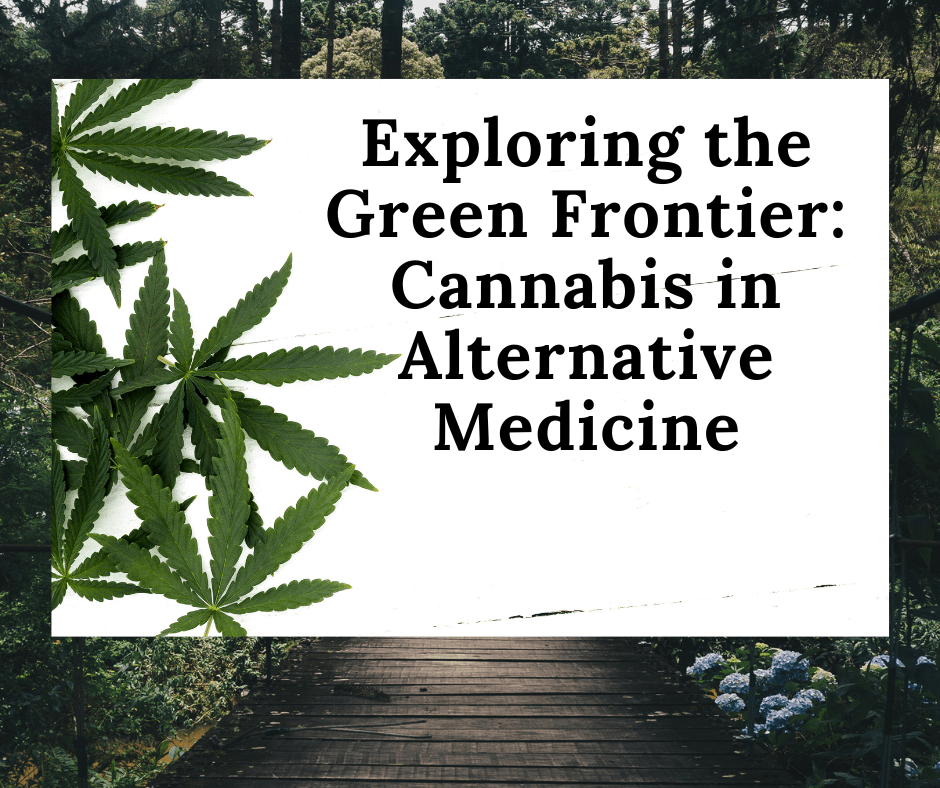Exploring the Green Frontier: Cannabis in Alternative Medicine

Exploring the Green Frontier: Cannabis in Alternative Medicine
Cannabis, Cancer, and Coming Full Circle in the Emerald Triangle
Let us delve into the often misunderstood yet increasingly important world of marijuana. For me, this journey begins not in a lab or a medical journal, but in my hometown of Arcata, California—a place nestled in the heart of what many call the Emerald Triangle. Comprising Humboldt, Mendocino, and Trinity counties, this legendary region has long been considered the epicenter of American cannabis cultivation. Growing up here meant being surrounded by dense redwoods, wild coastlines, and a revolutionary cannabis culture that shaped much of the local identity.
In the late 1960s and early 1970s, Arcata experienced a cultural renaissance as young people—mostly from urban areas—flocked to Northern California as part of the "back-to-the-land" movement. These modern-day homesteaders brought with them a deep respect for nature, sustainability, and community. They planted gardens, raised animals, and, yes, began cultivating some of the most renowned cannabis strains in the country. Marijuana was not just a pastime; it was a livelihood, a passion, and for many, a form of quiet resistance against a system they no longer trusted.
Despite this heritage, I never felt particularly drawn to recreational marijuana use myself. Growing up, I witnessed its normalization, but I also saw its misuse. It was everywhere—woven into the culture and economy—but it was never really my thing. I never felt the urge to use it recreationally, perhaps because I was always more focused on other aspects of life: cooking, writing, connecting, dreaming. Still, I respected it. I understood its cultural and historical significance, especially in a place like Arcata where it shaped both personal identities and public policy.
Lately, however, my relationship with cannabis has begun to shift. Ever since my diagnosis with Glioblastoma, I have started to reconsider its role—not as a recreational drug, but as a potential therapeutic ally. The idea of cannabis as medicine is not new, but it is gaining credibility in both scientific and mainstream conversations. I find myself more curious than ever: not as someone chasing a high, but as someone looking for hope, healing, and alternatives to traditional treatments that often come with unbearable side effects.
One of the most compelling aspects of cannabis is cannabidiol, or CBD, a non-psychoactive compound found in marijuana. Unlike THC (tetrahydrocannabinol), which gives users the familiar "high," CBD is associated with therapeutic effects—pain relief, anti-inflammation, anxiety reduction, and even anti-tumor properties. As I began reading more, I realized there is a genuine push among researchers to better understand how CBD might interact with complex diseases like cancer, including brain cancer.
But let us be clear: while the potential is exciting, we are still very much in the early stages of serious scientific validation. According to the FDA, the only cannabis-derived product currently approved is Epidiolex, which is used to treat rare and severe forms of epilepsy, such as Dravet syndrome and Lennox-Gastaut syndrome. Beyond that, everything else remains in a gray area of research, anecdote, and clinical trials in progress.
Still, the studies that do exist—especially those focused on glioblastoma—are intriguing. One recent piece of research caught my attention, published by Jagwire from Augusta University. The study explored how inhaled CBD affected glioblastoma tumors in experimental models. Not only did it slow tumor growth, but it also appeared to impact the tumor microenvironment (TME), which plays a vital role in cancer progression. Specifically, CBD suppressed certain proteins and immune checkpoints that typically allow tumors to thrive unchecked.
This is more than just a footnote in medical literature. The tumor microenvironment is like the secret sauce of cancer's success. It includes blood vessels, immune cells, fibroblasts, and other elements that interact with the tumor, often shielding it from the body's natural defenses. Altering that landscape—making it more hostile to cancer and more welcoming to the body’s immune response—is a strategy that many current therapies are chasing. That CBD might contribute to this effect is not just interesting—it is potentially revolutionary.
Of course, these findings are still mostly based on preclinical models—mice, petri dishes, and theory. There is a dire need for large-scale, double-blind, placebo-controlled human studies. Without that gold standard of medical research, doctors remain cautious. And rightly so. Cancer patients are especially vulnerable to false hope, and the supplement market is flooded with products that overpromise and underdeliver. We have to be careful not to replace one false narrative with another. Caution must coexist with curiosity.
Personally, I have not yet incorporated CBD into my treatment plan. But I remain open. I am watching the research closely. I am asking questions. I am reading, listening, and learning. Part of living with glioblastoma is living in constant pursuit of options. The traditional treatments—surgery, radiation, chemotherapy—are often brutal. If a natural compound like CBD can offer even a fraction of relief, whether through reducing tumor size or simply improving quality of life, it deserves serious attention and respect.
And then, of course, there is the human side to all of this. In the support groups I attend, both online and in person, cannabis comes up frequently. Some patients swear by it—for sleep, for nausea, for anxiety, for pain. Others have had mixed results. But what is undeniable is that many are looking for more holistic ways to navigate this disease, ways that honor not just survival, but dignity.
As someone born into the world’s most cannabis-rich culture and now facing one of the most aggressive brain cancers, I find it strangely full-circle to be exploring marijuana again—not through the lens of counterculture, but through the eyes of science, necessity, and hope. It is funny how life works like that—bringing you back to the beginning when you least expect it.
In conclusion, while cannabis, particularly CBD, is not a miracle cure, it represents a promising frontier in the world of alternative medicine. Especially for complex diseases like glioblastoma, where traditional treatments offer limited success, we must remain open to investigating new and potentially life-enhancing therapies. We need more research. We need more transparency. We need collaboration between patients, researchers, and policymakers to unlock the full potential of cannabis in a safe and ethical way.
If you are reading this and have your own thoughts, experiences, or research, I would love to hear them. The more we share, the more we grow—and in a battle as isolating as cancer, every piece of wisdom is a light in the dark.
Let us keep learning. Let us keep asking. And above all, let us keep believing that healing can come from the most unexpected places—even from the green hills of the Emerald Triangle.
Cited Research :
Baker, T. (2022, October 19). CBD reduces glioblastoma’s size, supportive environment in experimental model. Jagwire. https://jagwire.augusta.edu/cbd-reduces-glioblastomas-size-supportive-environment-in-experimental-model/



 NEW ARRIVALS
NEW ARRIVALS APPAREL
APPAREL GIFT AND HOME
GIFT AND HOME COLLECTION'S
COLLECTION'S HOPE HUB
HOPE HUB BLOG
BLOG



